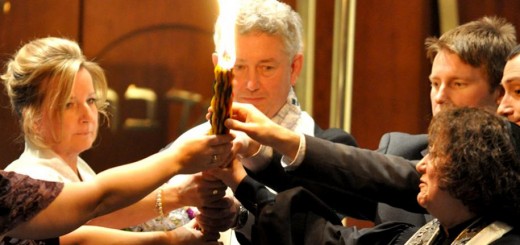Statistics, Lying Statistics, and Readers Digest

This post started out as an aside to an earlier discussion, concerning the chassid escorted off a Canadian plane because passengers became alarmed seeing him wrapped in his Talis. Frequent commenter Boruch Horowitz pointed out the risks of stereotyping with an interesting report: Readers Digest performed a somewhat whimsical global “Courtesy Test,” and determined that New York is the most courteous city in the world.
Yes, you can stop laughing. You already know that something is wrong with this test. Dave Barry entitled his blog entry “Reader’s Digest Pollsters: On Crack?”
Two unintended lessons emerge from the study: one in the power of “Lies, Darned Lies, and Statistics” — and a second, in the power of good training. Readers Digest skewed their numbers in several ways, all of which, not coincidentally, favored New York. As a survey of courtesy, the study was a failure. But what they did prove is that people can successfully train themselves to improve their middos, their character traits.
The Digest starts off with a demonstration of cultural bias, providing measures of “courtesy” not shared in other parts of the world — and not correcting their study even when they discovered the flaw in their yardstick.
What was most striking in Asia was how few people held doors open for us: Every city except Hong Kong finished in the bottom ten in the rankings, and not one had a success rate higher than 40 percent. Many Asians simply don’t include door-holding in their notions of courtesy. [Emphasis added.] “How can we measure someone’s value simply by whether they hold a door open?” observed 19-year-old student John Christopher Padilla in the Philippine capital, Manila.
If Asians don’t consider holding the door to be courteous, how can RD use that as proof that Asians lack courteousy? With this as one of only three measures of courtesy, RD thus effectively prevented any Asian city from ascending out of the bottom 50% of the rankings — even if the residents were exemplary in the other two areas, or any of many others which we would call courtesy.
None of the tests measured, for example, how people interact with others when behind the wheel. I don’t know how Asian cities do in this area, but I’ve experienced the thrill of navigating Manhattan on a weekday afternoon. A test of how frequently drivers permitted others to merge in front of them, for example, would surely have found New York jockeying for position at the opposite end of the spectrum.
The other test which I found interesting (for its unintended error) was in the area of customer service: “We bought small items from 20 stores and recorded whether the sales assistants said thank you.” Here, without question, the way they applied this to the city of New York was done in error.
In the days before EZ-Pass — or, at least, the days before I had EZ-Pass — a trip to New York inevitably involved real-life interactions with real, live toll-takers on the road from Baltimore. And I commented more than once that you could tell what state you were in by the reaction of the toll-taker to being handed your money. In Maryland it was “thank you, have a nice day!” In Delaware it was “thank you.” In New Jersey it was 50/50, but once you crossed the bridge into New York you were greeted with cold silence.
So imagine my surprise at reading that New Yorkers positively excelled in the area of thanking customers! 19 out of 20 New Yorkers passed this test?! It couldn’t be.
But, of course, it could. Because “for consistency, the New York tests were conducted at Starbucks coffee shops.” And thus the lesson of this survey has nothing to do with the inherent, native politeness of New Yorkers in this area (although it is worth noting, in the interests of fairness, that RD also found New Yorkers excel at holding doors) — and everything to do with the power of learning and training to elevate your character traits. This would explain why a city that I always found mediocre at best in this area — and readers can correct me if their mileage varies — was described as outperforming.
Nineteen of the 20 clerks who were subjected to service tests passed. Roger Benjamin, the manager and coffee master at a Manhattan Starbucks, acknowledged that the chain trains its employees to be courteous. And some baristas the RD reporters encountered went beyond basic niceties. “You have to feed off people’s vibes,” said one clerk. “You go out of your way to show customers they did us a favor by coming here.” At another store, a green-apron-clad attendant said that while courtesy was part of his job, he sought respect in return: “It’s contagious.”
Starbucks happens to have an intense employee-training program focusing upon customer service and satisfaction, covering everything from the way the “Barista” greets you at the door to how to describe blends of coffee. They have classroom training, they have on-line training, they have on-the-job training.
And, says my local expert in Starbucks employee training, “we say thank you for everything. Oh yeah. If the customer says thank you? We say thank you back.”
Many years ago, a group of educators approached Rabbi Moshe Feinstein zt”l, who was considered the pre-eminent Halachic authority in the United States. They suggested that perhaps boys should no longer begin the study of Talmud with somewhat arcane laws of damages. They asked if, perhaps, the boys ought to begin with Tractate Brachos (as they often do when beginning Mishnah), because the tractate discusses prayers that the boys say daily. How often does a boy’s ox gore his neighbor’s?
Reb Moshe answered that the standard practice was done with wisdom. A boy must learn, he said, that the laws governing our interpersonal interactions are every bit as much part of Torah as the laws of prayer. In a country where a frequent playground refrain is “finders keepers; losers weepers,” boys learn that the Torah obligates them to return a lost object when the owner can be identified.
Note that Starbucks’ employee training failed to achieve perfection. Despite their best efforts, one out of twenty failed to say thank you — even though Starbucks considers this a core obligation of their job. Just because you discover one failure, just because a news article might trumpet the discourtesy of one employee, this cannot justify a follow-up editorial claiming that this proves Starbucks’ employees are no more courteous than others. Training works, and the Torah schools do their level best to elevate each and every pupil to a level where a detailed code of interpersonal conduct is as instinctive as a thanks from a Starbucks barista. Do we fail in that regard, perhaps even 5% of the time? Surely. Does that remain far better than the national average? Unquestionably.




Perhaps Rav Moshe ZT”L with his innate genius could not appreciate the conceptual difficulty of Nezikin for most boys. RYBS ZT”L by contrast did not believe in teaching Nezikin to HS and younger children. It was an educational decision-not saying which is more important.
BTW-why not hilchot nzeikin the same way we teach children-hilchot tfillah, then they will see it is one big package.
“… Torah schools do their level best to elevate each and every pupil to a level where a detailed code of interpersonal conduct is as instinctive as a thanks from a Starbucks barista. Do we fail in that regard, perhaps even 5% of the time? Surely. Does that remain far better than the national average? Unquestionably.”
Are you saying that Yeshiva students are rude 5% of the time but that is okay because it is better than the national average?
OK how do you know this and how do you reach this conclusion about the level of tolerance that is acceptable?
Tzvee, I fail to see where I said that failures are acceptable. What I said is that they are inevitable, and thus a sad excuse for dismissing the overall value of training in moral areas, like any other.
Yeshiva students are not merely superior to their American peers in the area of rudeness, but in every impartial measure of interpersonal and teen behavior. This includes the likelihood to engage in drug or alcohol abuse, premature sexual activity, self-abusive and/or dangerous activities, vs. the likelihood to demonstrate concern for the well-being, property and dignity of their peers, those of the opposite gender, their elders, their teachers, and especially their parents. I know this because I have been through an ivy league college and several major yeshivos, and am not blind to the obvious.
I did not speculate on the exact frequency in any of these cases, nor did I say that any percentage is “acceptable.” To expect perfection, however, is to fail to acknowledge the reality of human nature.
mycroft, what R. Moshe said to the rebbeim in MTJ was that Gemara learning has started with Eilu Metzios since time immemorial and this may not be changed. He did not claim that Eilu Metzios is not intricate or difficult for kids to learn; he did explain the reason why it’s done despite the difficulty.
Okay, I’ll step up to the plate and defend NYC. I grew up in a city in the Southwest, my husband, in Silicon Valley, and upon our graduation from college almost three decades ago, we came to Los Angeles to stay. We had never visited NYC until about five years ago, before 9/11. We stayed a week there, travelling all over Manhattan and included a quick visit to the Bronx. We found New Yorkers to be warm, quite easy to strike up a conversation with. Everywhere we went, we had a nice time getting to know the locals. Yeah, there was one cranky bus driver and a cab driver who lost out on his tip when he tried to overcharge us. But the rate of misbehavior was no greater than what we experience in LA.
Let me tell you what really impressed us. This is something I’ve never seen in the cities we’ve lived in. From time to time we saw individuals coming out of a market and leaving food, without being asked, for homeless types that would park themselves nearby. In a couple of cases, the homeless were sleeping as an apple or a bottle of orange juice was left off.